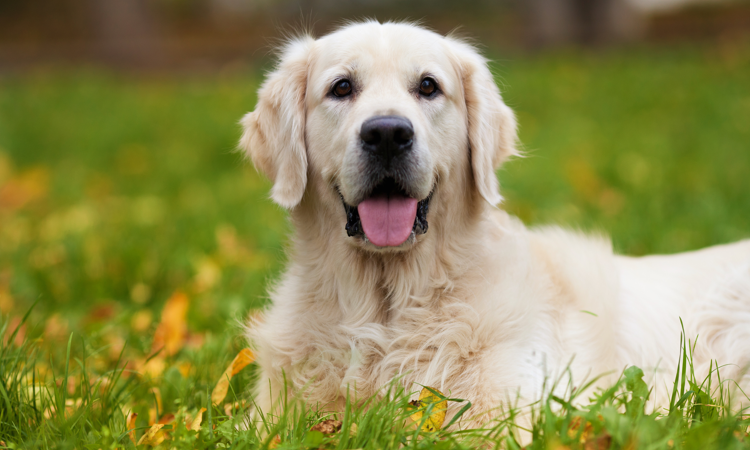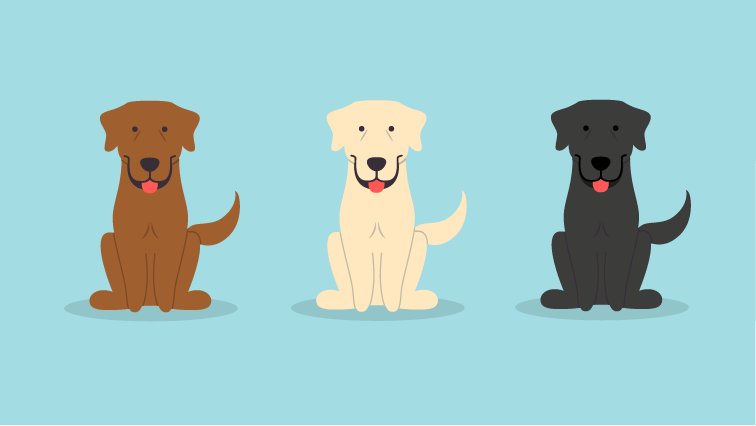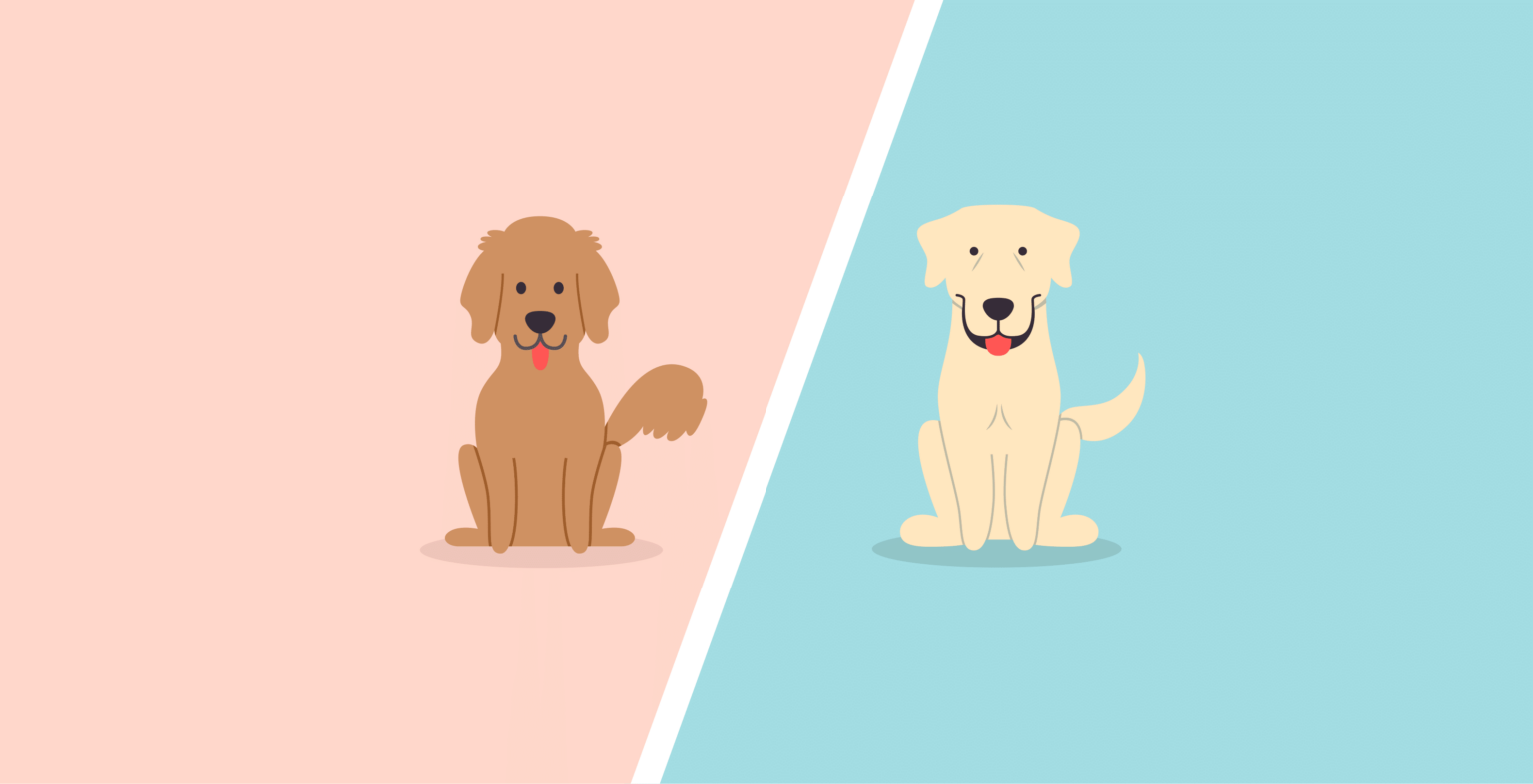Golden Retriever Vs Labrador Retriever – What’s The Difference?
Golden and Labrador Retrievers, or Labs and Goldens as they’re affectionately known by their fans, are two breeds who usually rank somewhere near the top of the nation’s favourite dog breeds. And it’s not hard to figure out why; both are fun-loving, super friendly, affectionate and energetic – which makes them ideal companions and family favourites. They share many of the same characteristics, though there are some tell-tail (sorry!) differences to watch out for. Don’t get your Goldies and Labs muddled – read our guide to discover what makes these breeds unique.
Their history

Golden Retrievers can trace their lineage to 19th Century Scotland where they were originally bred by Lord of Tweedmouth, Sir Dudley Majoribanks as hunting dogs, with the special job of finding and fetching game on land and water.
Majoribanks first started by breeding a yellow dog from Brighton and another (now extinct English Retrieving breed) called a Tweedwater Spaniel. Later, Labrador Retrievers, Newfoundlands, Red Setters and Bloodhounds were introduced to the breed.
In 1903, the breed was first named as the Golden Flat Coat by the Kennel Club of England and later showed in an English dog show in 1908. Golden Retrievers were introduced to the United States in the late 1890s and were given the name they’re known by today in 1920.
By contrast, the Labrador Retriever (or Lab for short) originates from 17th century Newfoundland, Canada and was first known as the Lesser Newfoundland. This breed is a descendant of the now extinct St. John’s Water Dog which is a cross between a Native Water dog and the Newfoundland. Like the Golden Retriever, Labrador Retrievers were first trained to retrieve fish from the cool Canadian waters and were then brought to the UK in the 19th century for their retrieval and hunting skills. Labradors got their name from the Earl of Malmesbury who wanted to differentiate the breed from their Newfoundland ancestry.
Labrador Retrievers Vs. Golden Retrievers Appearance
Comparing their snouts


Labs and Goldens both share folded ears, long tails, webbed feet and a love of water. Goldens have wavy, water-resistant coats and a longer snout to their Lab counterparts. Labs have a shorter, water-resistant coat, a broader head with pronounced eyebrows and a more muscular build.
Goldies Vs. Labs colourings

Labs come in three colours – chocolate, yellow and black, whilst Goldens come in a variety of shades from creamy blonde to a near red.

Both breeds have soft mouths which means they can carry items in their mouth without damaging them, which is what made them ideal canine candidates for hunting and retrieving throughout their history!
Labs vs. Goldens size


Both breeds are medium to large sized dogs but Labs are slightly larger than Goldens, and the males tend to be larger than females. That said, male Golden Retrievers are 58-60cm in height whilst females are 54-57cm. Male Goldies usually weigh between 29-34kg and females are usually 25-29kg.
Male Labrador Retriever are approximately 57-62cm high whilst female height ranges from 54-60cm. Male Labs can weigh between 29-36kg, while females should be between 25-31kg.
British vs. American Labrador and Golden Retriever breeds
Not to be confusing but there are difference between what is known as the British and American ‘standard’ bred Labs and Retrievers. The British Golden Retriever is slightly heavier and stockier than their American cousin, and have a broader skull and are more muscular. The British Goldie also tends to be slightly lighter in colour.
There are also differences between the British and American Lab. The American standard Lab is considered a ‘Working’ Lab whilst the British is known as a ‘Show’ Lab. Labs bred for show have become more common in the UK whilst Labs bred for hunting and field trials are known as American types of Labs.
Personality wise, the American Lab is more active and energetic than its British counterpart. British Labs also tend to be larger and have a calmer personality but both are equally friendly, playful and outgoing.
Do Golden Retrievers and Labrador Retrievers make good family pets?
Both Goldies and Labs are very popular family pets. They’re naturally affectionate and good-natured, as well as being gentle with children and other animals. Let’s take a bit more detailed look at what it’s like to own a Golden or Labrador Retriever.
Goldens vs. Labs – their personalities
Goldens and Labs share many personality traits. Both breeds have happy, easy-going temperaments, are eager for praise and affection and make perfect family pets. They share enthusiastic, happy demeanours and Goldens can sometimes look like they are smiling at their friends or owners. There are very minor temperament differences between the dogs. Generally, Goldens are a bit more soft and sensitive than Labs and may not brush off a scolding by their owner as easily as their Lab counterpart. How sweet!
Since Golden and Labrador Retriever are both sporting dogs they tend to have high amounts of energy and athletic tendencies. This makes them ideal service dogs and many of these dogs have made a name for themselves as disability assistance or search and rescue. They also need a lot of exercise and love long walks, a good run or endless games of fetch (that’ll be their retrieving skills!).
Both Goldens and Labs are great swimmers and will happily run into the water to fetch a floating toy or stick. Their high energy and enthusiasm needs to be met with a lot of love and attention from their owner. Neither breed likes to be left alone so it’s important to have a lot of time to spend with your furry companion.
In general, Goldens and Labs are both intelligent dog breeds and are easy to train and quick to learn. Like most dogs, they are motivated by food, so a great way to train is by rewarding their good behaviour with a tasty treat. As well as being great family dogs, both breeds get along well with other dogs and cats so they’re a good choice for multi-pet households. Don’t expect either breed to make good guard dogs, though. Labs and Goldens are simply too friendly to guard your home or belongings properly and are more likely to greet an intruder warmly than be protective.
Lab vs. Retriever grooming
Golden Retrievers need regular grooming. They have a medium length, wavy, double coat consisting of a water repellent top coat and a soft undercoat. Their undercoat grows more dense in cold months and sheds during warmer weather. Labs also have a double coat – their undercoat keeps them warm during colder months, too but their top coat is shorter than a Retriever’s.
Labs also need regular grooming but are less high maintenance than Goldens. Frequent brushing for Goldens is recommended, plus regular trimming of their longer fur around their ears, feet, neck, and tail.
Labradors don’t have longer fur around their ears, feet, neck and tail so they require less trimming than a Retriever. Their coat is shorter so they can be bathed less frequently than Goldens.
Labs vs. Goldens shedding
Goldens and Labs shed a similar amount but Goldens usually require more day-to-day grooming. Although Goldens have a longer top coat than a Labrador, both dogs shed quite a bit.
Goldens shed the most during the spring when their undercoat grows thick and moults. The term ‘blowing the coat’ was coined to describe their extensive shedding. Whilst a Labrador’s hair is shorter, they still shed a lot, particularly their undercoat during warmer weather, too.
A few tips for these heavy shedders. Don’t wear black, as their light hair will be more visible on dark clothing, and groom your dog outside to avoid excess hair in your home. Both dogs would benefit from almost daily brushing with a slick brush and groomed with an undercoat rake. The undercoat rake is the best way to deal their shedding during warmer months.
Labs vs. Goldens health
All purebred breeds like the Golden Retriever and Labrador Retriever can have inherited health problems. Here are a few you need to look out for.
Both dogs have high cancer risk, can suffer from obesity, have hip and elbow dysplasia, eye disease or ear infections.
The cancer risk is higher in Goldens than Labs with over 60% of the dogs developing cancer during their lifetime.
Labs are more prone to obesity than Goldens so it’s important that they get a lot of exercise and their weight is managed. Comparing the two dogs, Labs may be the healthier breed as much of their health problems can be avoided by testing.
Do you prefer a Golden to a Lab? Share your favourite breed with us on Twitter or Facebook, or in the comments section below.

